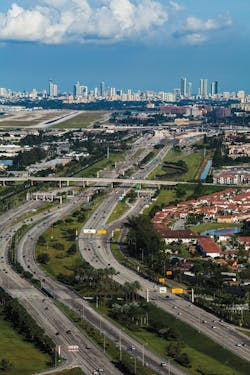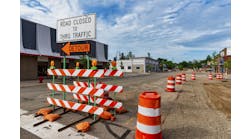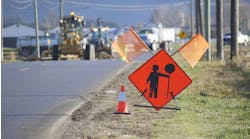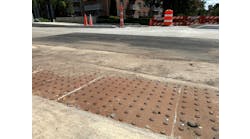In the far-flung world of intelligent transportation systems (ITS), forces are beginning to coalesce toward a goal of a much more efficient and safer environment.
This is especially true for the regime of cars, trucks and transit vehicles. The U.S. DOT’s Research and Innovative Technology Administration (RITA), along with eight automakers, is forging ahead with a safety pilot in Ann Arbor, Mich., run by the University of Michigan Transportation Research Institute (UMTRI).
The connected-vehicle program so far involves 2,836 cars and trucks and 73 miles of equipped roadway, using radio waves for vehicles to communicate with one another when the threat of a crash rears its head to give the driver an audible or visible warning so the driver can take proper crash-avoiding action. To broaden the test a bit, UMTRI added six motorcycles and a bicycle to the mix this past summer.
So far, the tests have involved signals between vehicles (V2V), but the sponsors envision expanding the program later to include signals between vehicles and the roadside infrastructure (V2I), also involving transit vehicles and migrating to having the vehicle take over control of itself when sudden swerving or braking becomes necessary.
Meanwhile, some auto companies, and even Google, are moving fast on their own with development of cars that control some or all of the vehicle’s operation, either partly or entirely controlling the car’s driving, braking, turning and other moves. Thus, development of these autonomous vehicles (AVs) could, in effect, pre-empt the advanced stage of the government’s connected-vehicle effort, or perhaps more likely, end up being married to it.
“Cars are a lot smarter than people,” said Scott Belcher, president and CEO of the Intelligent Transportation Society of America. “The idea is that the car can be doing a whole lot by itself, and you can be doing something else.”
More than symbolically, this year’s ITS World Congress will be held in Detroit Sept. 11-17.
So the dual-track ventures are heading toward what could become a powerful ITS tool, or bag of tools, with major safety and other promises for motorists and transit users. The U.S. DOT estimates, for example, that connected vehicles could reduce highway deaths not involving drunken drivers by 76%.
Accident-free vehicles
“We in the transportation industry can now envision a future with accident-free vehicles, vehicles that can at times drive by themselves and vehicles, drivers and transportation infrastructure that are connected safely and securely for reliable information sharing,” Kirk Steudle, director of the Michigan Department of Transportation (MDOT) and former president of the American Association of State Highway & Transportation Officials (AASHTO), recently testified before the House subcommittee on highways and transit.
As has long been true, there are many other things making progress on the ITS front, often slowly, but with the promise of surely. Here are several, in varying stages of development or deployment:
- Integrated corridor management (ICM) coordinating multiple modes of travel within busy transportation corridors;
- Transit and high-speed trains getting more ITS attention;
- Toll roads and high-occupancy toll (HOT) lanes as a way to control traffic congestion while also raising needed transportation revenues;
- Active traffic management, with variable-speed lanes and adaptable ramp metering and traffic signals;
- Sophisticated traffic measuring and distributing this intelligence to transportation control centers and motorists; and
- Imaginative schemes to streamline parking, car sharing and ride sharing, relying heavily on smart phones for communication.
Sour squeeze
There remains, however, the constant need for more ITS money. “We are struggling with funding,” said Steudle. “It’s all about taking the existing revenue stream and squeezing more out of it.”
“There’s a lot of money available for ITS research, but not for deployment,” said Hariharan Krishnan, GM’s R&D technical fellow for Perception and Vehicle Control Systems.
Toll roads and HOT lanes are becoming favorites of many state transportation planners, partly because they often produce enough revenue to pay for other, unrelated costs. Jason Stuart, a project controls director for RS&H, a facilities and infrastructure consulting firm, ticked off five major toll roads currently under construction in Texas, with a combined length of roughly 225 miles and an estimated $9 billion total cost. Helping speed the toll-road boom along is a trend toward public-private partnerships, which states or other authorities often find favorable, Stuart said.
Having one or more HOT lanes is also gaining, due to their revenue and congestion-controlling features. HOT lanes were completed in early 2013 in Texas along 83 miles of U.S. 59, U.S. 290 and I-45 and in November 2012 along 28 miles of Virginia’s share of I-495, the Washington, D.C., beltway. And HOT lanes are being built on Florida 95, converting existing HOV lanes.
Another financing approach involves taxing vehicles on the basis of miles traveled, (vehicle-mileage tax, or VMT), rather than fuel consumed, with fuel-tax revenues declining. In Oregon, a Road User Charge for cars and light trucks goes into effect on July 1, 2015, after trials in 2007 and 2012. Participation in the program is voluntary for 5,000 motorists, and involves a 1.5 cents tax per mile, replacing the state’s fuel tax of 30 cents per gallon.
The Washington state DOT has begun studying the VMT concept, while those in Arizona, West Virginia, Florida and Wisconsin are considering doing so, AASHTO said. Meanwhile, Virginia’s legislature replaced the state’s 17.5-cents-a-gallon tax on gasoline and diesel fuel last year with 3.5% and 6% taxes, respectively, on the wholesale price of gasoline and diesel fuel, the state’s first comprehensive transportation-funding bill in 27 years.
Connectivity
But the two hottest ITS topics these days are connected and autonomous vehicles. The connected-vehicle effort has gone through several iterations over the years, but the U.S. DOT settled on the name “connected vehicle” and began the testing in August 2012, first seeking the opinions of drivers about their experiences with the V2V testing. Fully nine out of 10 of those questioned gave a favorable response.
The testing is going “well,” Debra Bezzina, project manager for the endeavor, said recently. The crucial verdict was to be issued by the National Highway Traffic Safety Administration on whether the pilot project justified the start of regulatory rulemaking, which would be a green light for the program, for V2V for cars.
The pilot was to end in February, but the U.S. DOT extended the project for six months to keep the program in a “ready state” for possible add-on work, Walt Fehr, a department official, said in a recent meeting. Expansion of the project is definitely planned.
Urban complexity
Meanwhile, the University of Michigan in October 2013 announced plans for a test location involving a simulated urban environment, for testing “an entire system of connected and automated vehicles,” to be followed by further testing “on the streets of southeastern Michigan [mostly Ann Arbor and vicinity] by 2021.”
To be located on 30 acres of the university’s North Campus Research Complex, the urban test environment will include about 3 lane-miles of roads with intersections, traffic signs and signals, sidewalks, benches, simulated buildings, street signs and obstacles such as construction barriers.
“One of the major challenges ahead is to ensure that these vehicles can perform safely and reliably in a complex urban setting,” said Peter Sweatman, director of the Michigan Transformation Center. Testing that kind of urban environment is needed, he said, “before a significant number of vehicles can be safely implemented on actual roadways.”
Meanwhile, auto companies have offered a range of self-deploying car technology, like warning sounds, visual warnings or even vibrating seats, to warn drivers of threats such as a stopped car ahead, another vehicle in the driver’s blind spot or that their own vehicle is drifting into an adjacent lane.
But the automakers are going well beyond those warning devices—developing semiautonomous vehicles for now and aiming at fully autonomous ones later. While Nissan, for example, offers a raft of such safety devices on various models, it also offers or will later offer Infinitis and some other models that have such features as warnings of something in the way while backing up, or of an imminent forward collision. But if the driver does not put on the brakes, his car will do it for him, also helping the driver steer his vehicle back into his lane when it wanders.
Nissan plans to introduce a fully automated car by 2020, when it hopes to have the self-braking technology perfected, said Andy Palmer, senior vice president.
Krishnan noted his industry’s speedy advance toward autonomous vehicles. “[Automotive] people realized that the full effect of autonomous driving required connectivity,” he said. “But nobody wants to wait until all the details are finalized.”
Then there’s Google, and the self-driven car. Google said that the self-driven car uses a laser range finder, GPS, four radar units, high-resolution maps, a camera, an inertial measurement unit and a wheel encoder.
Before a self-driving car can drive itself down a road, Google said it creates a detailed digital map of all the features of the road—lane markings, intersections, exit ramps and even buildings near the road—using the cameras, laser sensors and radar. Then, when the car later drives a route without driver assistance, the car combines the existing data about the road’s permanent features with real-time information about where road obstacles and other cars are and how fast they are moving. To know where it is on the road, a self-driving car relies on a combination of the prebuilt digital map, a GPS, accelerometers and gyroscopes—tools to measure how the car is moving.
Using a small fleet of Lexus vehicles, Google has obtained approval to test the self-driving auto in Nevada, Florida and California. It is required to have a person in the driver’s seat to take over if necessary, but basically is in fact self-operated. The company said recently that its test fleet had driven more than 500,000 miles.
Now, companies including Mercedes-Benz, GM, Nissan, Toyota and Audi are active in AV endeavors, and they and other companies have predicted various AV developments between 2012 and 2020.
The following is a brief rundown on some other ITS developments.
ICM and other multimodal projects
San Diego’s I-15 and Dallas’ I-75 corridors last year launched pilot projects designed to impove safety, reliability and efficiency by melding management of highway, arterial, transit and parking into one system.
The Dallas corridor, for example, once integrated, is expected to save Dallas travelers 740,000 in personal hours and 981,000 gallons of fuel annually, with a 10-year $264 million net benefit, for a 20:1 benefit-to-cost ratio, as reflected in a recent presentation by Koorosh Olyai, assistant vice president for mobility programs development at Dallas Area Rapid Transit.
Additional cities considered pioneer prospects for future corridors include Minneapolis, Oakland, San Antonio, Houston, Seattle and Montgomery County, Pa.
Other multimodal projects on RITA’s plate, for the long range, include a new generation of traffic- signal systems seeking to provide a more comprehensive bundle of information—how far away traffic is, for example, for general and emergency vehicles, transit, freight fleets, pedestrians and bicyclists, in a connected vehicle.
They also include interoperable fare payment systems that can be used by all modes of transportation at all times, a more sophisticated inspection technique that can be used to inspect bridges and other transportation infrastructure.
New parking, car-/ride-sharing ventures
An era of cars that park themselves and cyber-locating of available spaces far ahead is dawning. More and more, parking can be paid with credit cards or smart phones, and services that help motorists locate available parking spots where and when they want them are springing up.
ITS America held a parking symposium last March in Berkeley, Calif., along with ITS California, Caltrans, the Metropolitan Transportation Commission and the Green Parking Council. More than 150 participants mulled over the latest parking strategies and explored ways to put more effective parking into operation, from demand pricing, mobile-payment systems, advanced meters and parking-spot occupancy sensors to real-time parking information for commuters and commercial-parking operators.
They concluded, among other things, that commercial parking garages and lots are a fruitful market for smart parking but difficult to enter, considerable greenhouse gases and 50% of congestion costs are due to inefficient parking, and smart parking will be an important tool for cities. However, until mobile phones and credit cards are truly ubiquitous, cash-operated parking payment will continue to be needed.
Traffic management and advisories
Some states are developing or using improved methods for controlling traffic, depending on traffic flows. At Caltrans, for instance, “We have 60% of the ramp-metering signals in the U.S., and there has been a 15-30% reduction in travel times by using adaptive ramp meters, better calibrated to show traffic flows,” said Joan Sollenberger, chief of the division of strategic operations at the California Department of Transportation (Caltrans). “But much more is needed to get low-cost, high-payoff additional benefits.
“It all adds up to, with limited space and money for new lanes, an upcoming focus on maximizing flow on existing freeways through use of technology such as a network of cameras, above-road detectors, message boards and in-road loop sensors. This allows the traffic-management centers to monitor incidents and events and to respond as quickly as possible to get them cleared.”



